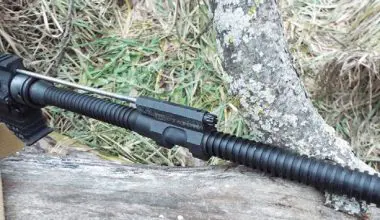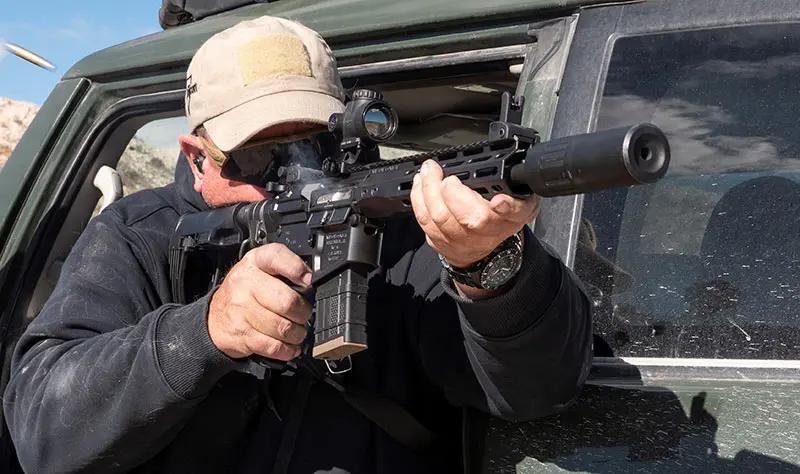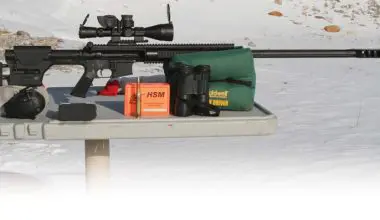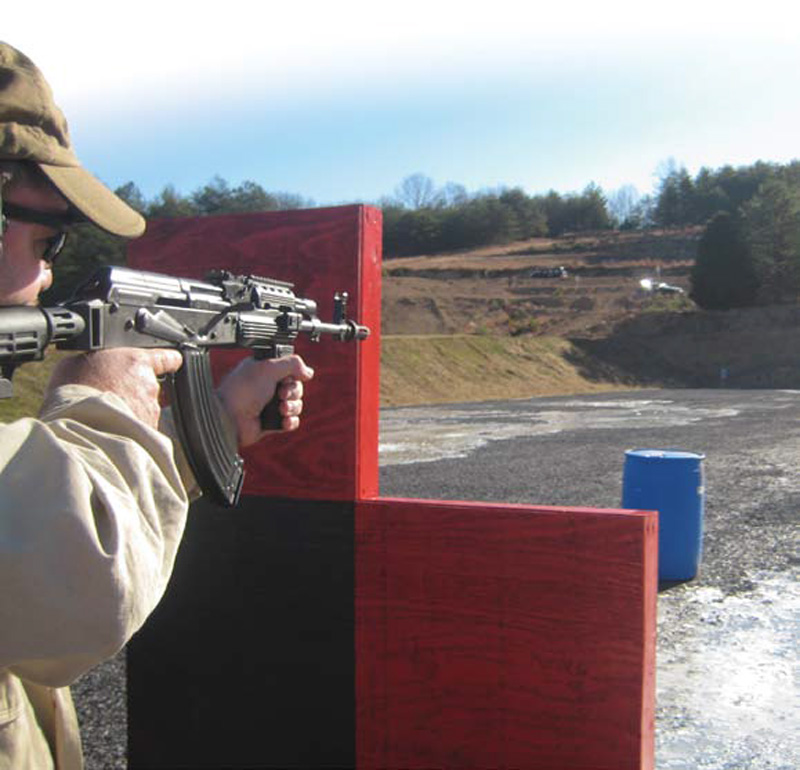
Despite the nefarious 1989 Import Ban and expired 1994 Assault Weapons Ban, the AK series of weapons has never been more popular in the United States than it is now. This is due to the AK’s well-earned reputation for ruggedness, reliability and, up until recently, low price point for rifles and ammunition compared to ARs.
Lessons relearned in Iraq and Afghanistan about terminal ballistics are enhancing 7.62x39mm AK credentials. There are 7.62x39mm loads ranging from 122 to 154 grains in FMJ, HP and SP that perform very similarly to the .30-30 in terms of ballistic performance. A recently introduced Hornady offering is further proof that the AK is here to stay.
The Kalashnikov long-stroke gaspiston operating system is a benchmark in terms of reliability for other actions. A key component in the AK design is the looser tolerances in its moving parts, giving it more latitude to function when dirty from field conditions or hot and grimy after firing numerous rounds over extended periods of time. This translates into reduced sensitivity to debris in the action and ultimately lowers maintenance requirements to keep it functioning.
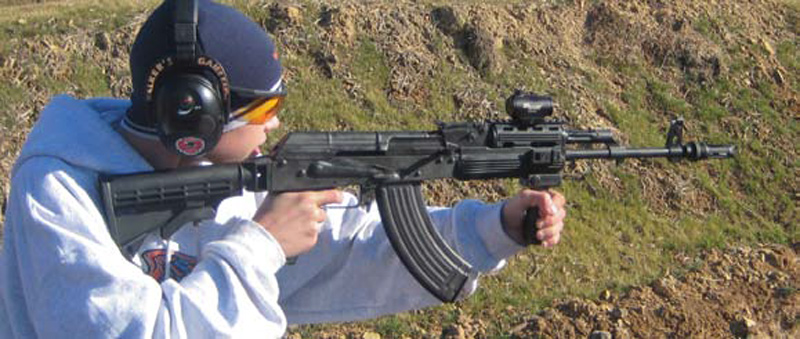
Table of Contents
THE CENTURY CONNECTION
Century International Arms has long been at the forefront of the rising AK popularity stateside due to the multitude of AK products it offers. The Century model tested was the GP1975 chambered in 7.62x39mm. Century lists two separate GP1975 variants in its catalog. The GP1975 evaluated had received some extras from Century in the way of a Tapco adjustable collapsible buttstock and TDI top and bottom handguards.
The cross-influence of the AR is evident in the GP1975, with handguards that feature rails to accept the mounting of accessories such as optics, lights, lasers, and vertical foregrip. Some may find accessorizing the AK an act of heresy, but many more will take advantage of the capability offered by the railed handguards.
From what I can determine, the GP1975’s stamped receiver is U.S. made, along with the 16.25-inch non-chrome lined Green Mountain barrel, Tapco adjustable rear stock, TDI handguards, and Tapco G2 trigger group. Century literature lists the barrel as featuring four-groove 1:9.5-twist rifling. A slantstyle muzzle compensator is screwed on the barrel. Overall length of the GP1975 AK is 34 inches with stock collapsed and 37.5 inches extended. It weighs slightly less than seven pounds.
AT THE RANGE
After a quick verification of 25-yard sight zero, range evaluation commenced with a function test involving firing several magazines in rapid succession at various steel man targets and vehicles that dot the range where I do my testing. While not unique, this is a good way to establish a baseline for reliability. Let’s face it, if an AK-type weapon does not have pristine reliability, its major attribute is nullified.
I made sure to use different types of AK-47 magazines, to further root out any manufacturing quirks that might exist in the GP1975. Metal and polymer 30-round magazines from various manufacturers performed fine, with no issues inserting, removing, or feeding the Century GP1975. New polymer magazines were a tight fit initially, but wore in after multiple uses.
A more comprehensive 100-yard sight zero confirmation took place after functionality had been established. The TDI handguard allows for the open sights to be viewed down the recess between the rail system. I noticed that the rear sight needs to stay on the first setting, which is a battle sight designation, due to the 100- and 200-meter markings moving the rear sight below the rail height, making the front post impossible to view in conjunction with the rear notch. I did not find this an issue, considering it’s unlikely that I would adjust the AK sights to anything besides the first setting.
SIGHTS AND AMMO
This thinking reinforced my decision to mount a SIG Sauer STS-081 Mini Red Dot Sight on the forward rail. This sight is often maligned as being a “knock off,” and does not enjoy the deserved reputations of an Aimpoint or Trijicon. I find the SIG Mini Red Dot worthy of consideration based on use with various rifles. The SIG sight withstood the recoil and heat generated by repeated long strings of fire.
Red dot sights offer the capability to engage multiple targets in rapid sequence compared to open sights. The single focal plane with the red dot is easier to shoot accurately than coordinating front and rear sights.
Wolf Ammunition 122- and 124-gr. loads hovered in the three-inch range at 100 yards, with surplus Egyptian and Yugoslavian 7.62x39mm producing only slightly larger groups.
One downside to surplus ammunition is that it does utilize corrosive primers. The Russians and other ex-Soviet bloc states insisted on using these due to concerns with cold-weather ignition and the long-term storage capabilities offered by corrosive primers. However, stocking up on it cannot be resisted, considering that it can still be found at 25 cents a round or even cheaper! As long as proper cleaning methods are followed to remove elements left over from the primer residue, corrosive ammunition does not destroy rifles as many would lead you to believe.
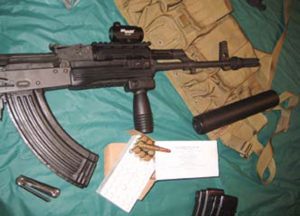
The GP1975 does not feature an integral side scope rail, prohibiting mounting of a magnified optic for more precise accuracy tests. Three inches at 100 yards with a 9.5-inch sight radius strikes me as more than acceptable for an AK or any other open-sighted rifle with my eyes. The forward-mounted SIG Mini Red Dot produced similar accuracy.
DRILLS
Range tests consisted of completing numerous runs on a carbine course previously set up for a law enforcement competition. Several clusters of IPSCstyle man targets were engaged from various firing positions. Multiple shots were fired at each target, with a magazine change mandated before leaving cover.
The various stages consisted of three different styles of barricade, including one coming through an operable doorframe. I find testing any rifle in this format helps to highlight both strengths and weaknesses in handling and weapon manipulation.
While not as subtle or tame as an AR-15 or AK-74, the GP1975’s muzzle blast and recoil were neither prohibitive nor excessive, and allowed for fast double and triple taps on targets at CQB distances.
The SIG Mini Red Dot Sight assisted in engaging targets at close distances, with the red dot easy to pick up rapidly while at the same time allowing for more than enough accuracy out to a couple hundred yards. This was due to the red dot superimposing an aiming point on the target while not totally obscuring the target because the dot was not that large.
Team tactics exercises that involve moving to and from a designated target area using cover while either changing magazines or engaging targets as a partner reloads are also good weapon evaluation drills. One gets a good sense of the way a weapon handles, along with its reliability, due to the amount of ammunition expended in the short time frames characteristic of these drills.
Other training exercises, such as magazine changes, shooting from the non-dominant shoulder and unconventional positions helped put the GP1975 through its paces. The adjustable collapsible stock, like the M4, was a plus during these tests because the length of pull could be modified for efficiency.
Strings of fire ranged from 15 rounds to 85 rounds, with target distances measured in feet out to 200 yards. The GP1975 handled as expected from an AK, combined with perfect reliability. Other non-scientific tests consisted of blazing away at targets of opportunity located around the range, such as steel MGM targets, car hulks and manhole covers.
Total rounds fired over several range visits were more than 1,400. The rifle was cleaned between range sessions due to the use of corrosive ammunition.
ADD-ONS
In an effort to determine the flexibility of the GP1975, I replaced the slanted muzzle device with a Yankee Hill Machine (YHM) Phantom Flash Hider. The Phantom Flash Hider is not only an ingenious mounting system for a YHM suppressor body, but also an effective flash hider in its own right.
I could not resist trying out some Engel Ballistic Research (EBR) 7.62x39mm 220- gr. Jackhammer subsonic loads with the Century GP1975. The Jackhammer load is unique in the industry in that it is designed to cycle in platforms with or without a suppressor mounted in both semi- and full-automatic modes. EBR reports that AK weapon platforms can be made to work reliably with the Jackhammer after slight reworking of the feed ramp. The light recoil of the subsonic Jackhammer load makes it extremely controllable in full-auto mode.
Century’s decision to equip the GP1975 with railed handguards is most appreciated for mounting a vertical foregrip (VFG). The VFG has fast become a standard accessory on any rifle or carbine equipped with an accessory rail. The increased leverage and control offered by the vertical foregrip aid in weapon manipulation and stability when firing.
The GP1975 was manipulated easily with the VFG mounted, even when forced into unorthodox positions when engaging targets while moving or firing around barricades. Use of a weapon’s magazine well as support for the offhand makes it much easier to inadvertently— and painfully—get a finger in the way of the weapon’s reciprocating bolt handle when firing.
A compact VFG mounted as far forward as possible is necessary so as not to interfere with magazine changes on an AK. Users are encouraged to verify and train with all equipment before committing to use. Finally, another reason why I prefer a vertical foregrip is that when a rifle’s handguard is smoking yet staying operational after taking the abuse that the AK is famous for, a vertical foregrip is perfect for keeping your hand away from the barrel.
CONCLUSIONS
The Century GP1975 proved reliable at the range and handled as expected from an AK. The adjustable buttstock and railed handguards are useful features. Yes, there are other, more expensive accessories available, but the fact is that the Century GP1975 works fine as it is equipped, and it provides typical AK functionality.
The Century GP1975 proved itself worthy of being labeled an AK, with all the connotations that implies. Put simply, the Century GP1975 AK is a 30-round detachable magazine semiautomatic with great handling and the means to add accessories as a user sees fit. It is ultra reliable firing a cartridge that shares the same basic ballistic performance as a .30-30.
